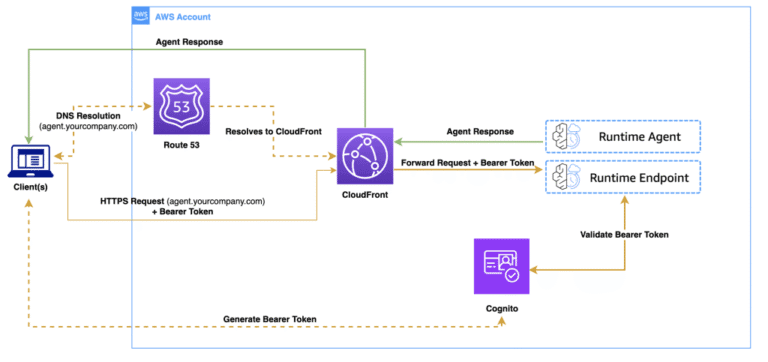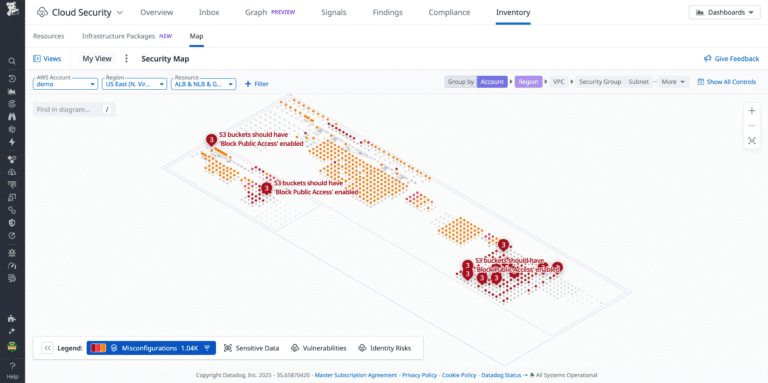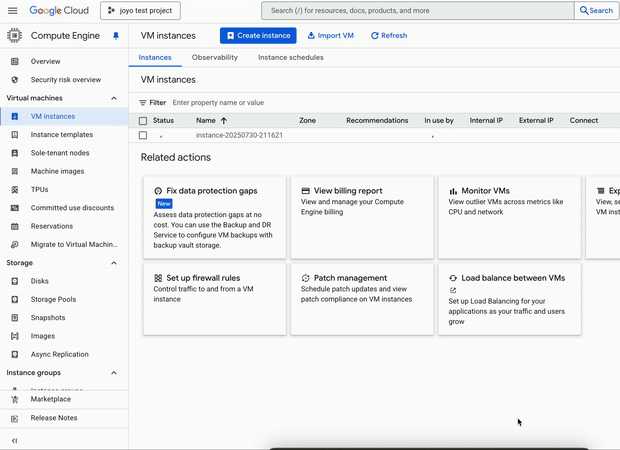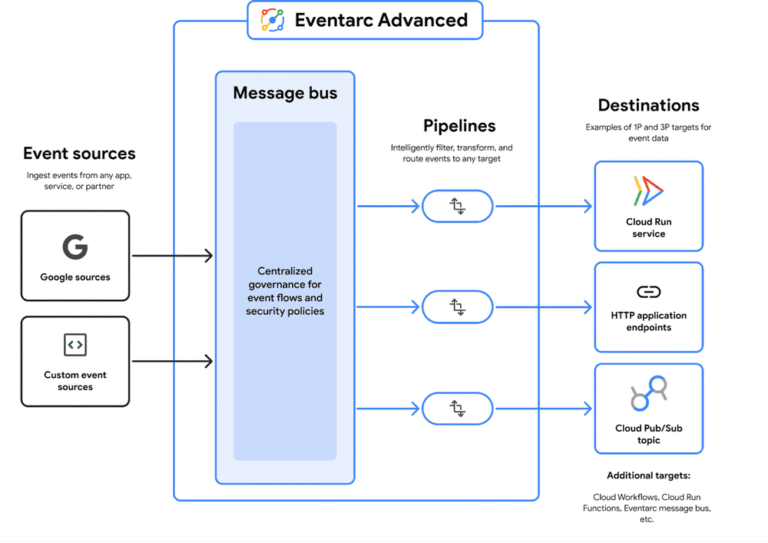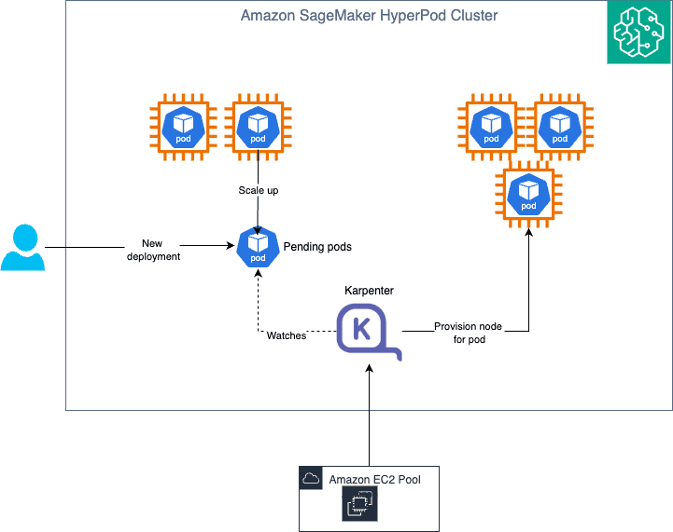Want to know the latest from Google Cloud? Find it here in one handy location. Check back regularly for our newest updates, announcements, resources, events, learning opportunities, and more. Tip: Not sure where to find what you’re looking for on the Google Cloud blog? Start here: Google Cloud blog 101: Full list of topics, links, and resources. Aug 25 - 29 Applied AI for Modern Manufacturers: New original growth series, hosted by Jake Hall, The Manufacturing Millennial, that dives into leading trends, best practices, and what companies are doing right now with AI in manufacturing. Hear from industry thought leaders - Rick Bullotta, Jonathan Wise, Walker Reynolds and Berardino Baratta - and Google Cloud experts - Praveen Rao, Eric Lam, Dave Nguyen Ph.D., Geoffrey Hirschheim, and Jim Anderson. Watch Modules 1 and 2 now, where we delve into the AI Innovation and trends and AI Costs and ROI in the Era of Digital Manufacturing. Next module kicks off Tuesday, Sep 2. Join now Firestore with MongoDB compatibility is now generally available (GA): Developers can now build cost-effective, scalable, and highly reliable apps on Firestore's serverless database using a familiar MongoDB-compatible API. With the general availability of Firestore with MongoDB compatibility, the 600,000 active developers within the Firestore community can now use existing MongoDB application code, drivers, and tools, as well as the open-source MongoDB ecosystem, with Firestore's serverless service. Firestore offers benefits like multi-region replication, virtually unlimited scalability, up to 99.999% SLA, single-digit millisecond read performance, integrated Google Cloud governance, and pay-as-you-go pricing. Register now for the webinar on September 9th for a deep dive into Firestore with MongoDB compatibility. Aug 18 - 22 Earth Engine in BigQuery is now Generally Available, bringing advanced geospatial analytics directly to your BigQuery workflows. Unlock insights with satellite data! Aug 11 - Aug 15 New HPC VM and Slurm-gcp Images: A new HPC VM Image (under the project cloud-hpc-image-public) is now available, featuring a Rocky Linux 8-based image, IntelMPI v2021.16, and RDMA drivers. In partnership with SchedMD, new Slurm images (Slurm 25.05) have also been released. These are based on the latest HPC VM Image and are available for Ubuntu 22.04/24.04 Accelerator Images (ARM/AMD64) and Debian 12. These releases allow for the deployment of Slurm-ready clusters on GCP, providing the advantages of an HPC-optimized and performance-tested foundation. Read more. Scaling our Gemini Embedding model in Vertex AI. Following increased popularity from its General Availability launch in May, we've recently increased quota and input size limits for customers of Vertex AI's most powerful text embedding model, gemini-embedding-001. Customers can now send up to 250 input texts per request (generating 250 embeddings) instead of only a single piece of text, bringing improved throughput and decreased round-trip network latency to large-scale embedding applications. We've increased quota limits for this model by 10x for most users, allowing hassle-free scaling of embedding applications to millions of tokens per minute and beyond.Get started with Gemini Embeddings today! Aug 4 - Aug 8 GKE Node Memory Swap in private preview: You can now configure swap space on your GKE Standard nodes to provide a crucial buffer against Out-of-Memory (OOM) errors for memory-intensive applications, especially during unexpected usage spikes. Enabling swap can improve workload resilience, reduce pod evictions due to memory pressure, and enhance overall application stability and cost-effectiveness. This feature is currently available in a private preview. Contact your Google Cloud account team for more information and to request access. If you'd like to see more configurations, please contact your account team or make a feature request on our issue tracker! Unlock Peak Performance: GKE Topology Manager is Now Generally Available: For customers running performance-sensitive workloads like AI/ML and HPC, GKE Topology Manager is now GA and ready to optimize your performance through NUMA alignment. By ensuring CPU, memory, and GPU resources are allocated on the same NUMA node, the Topology Manager minimizes cross-socket latency and maximizes throughput for your most demanding applications. Configure your alignment policies via the NodeConfig API to achieve significant performance gains. Achieve these performance gains by configuring your alignment policies via the NodeConfig API. If you'd like to see more expansion of Topology manager, please contact your account team or make a feature request on our issue tracker! Fine-Tune at Scale: A Massive GKE NodeConfig Expansion for All Workloads: GKE has massively expanded node customization capabilities, adding nearly 130 new Sysctl and Kubelet configurations. This gives you finer-grained control for any workload needing node customization, performance requirements, or application-specific tuning. By replacing complex DaemonSets with native controls, you can benefit from enhanced security, high flexibility, faster node startup times, and less operational management. Check out our public documentation to learn how to consume these new NodeConfig options. If you'd like to see more configurations, please contact your account team or make a feature request on our issue tracker! New capability for managing licenses in Compute Engine: We are announcing a new capability in Compute Engine which allows users to easily change the OS licenses on their VMs. Users can now append, remove, or replace OS licenses, enabling seamless transitions between license types—such as converting Red Hat Enterprise Linux from pay-as-you-go (PAYG) to bring-your-own subscription (BYOS), or upgrading from Ubuntu to Ubuntu Pro—without needing to redeploy instances. This feature empowers customers to meet their evolving licensing with speed and flexibility. To learn more, read about managing licenses on Compute Engine. GKE Turns 10 Hackathon: Calling all developers! Google Kubernetes Engine (GKE) is turning 10, and we're celebrating with a hackathon! Join us to build powerful AI agents that interact with microservice applications using Google Kubernetes Engine and Google AI models. Compete for over $50,000 in prizes and demonstrate the power of building agentic AI on GKE. Submissions are open from Aug 18, 2025 to Sept, 22 2025 Learn more and register: gketurns10.devpost.com Jul 28 - Aug 1 Now GA: C4 VMs with Local SSD, bare metal, and larger shapes, on Intel Xeon 6: C4's expanded shapes are now GA! This expansion introduces C4 shapes with Google’s next-gen Titanium Local SSD, C4 bare metal instances, and new extra-large shapes, all powered by the latest Intel Xeon 6 processors, Granite Rapids. We’re excited to be the first leading hyperscaler to bring Xeon 6 to customers, delivering performance gains of up to 30% for general compute and up to 60% for ML recommendation workloads, and up to 35% lower access latency on Titanium Local SSD shapes. Learn more here! Jul 14 - 18 DMS SQL Server to PostgreSQL migrations are now generally available! Accelerate your SQL Server modernization to Cloud SQL for PostgreSQL or AlloyDB for PostgreSQL with: Automatic database schema and code conversion Gemini augmented code conversion Gemini assisted PostgreSQL training and code improvements Low-downtime, CDC based data movement Learn more and start your migration journey today! Jul 7 - 11 Level up your AI Agent game with "The Agent Factory," a new video podcast for developers! We're going beyond the buzz to explore practical design, build, deploy, & management strategies for production-ready AI agents using Google Cloud. Expect code snippets, architecture deep dives, and integrations with open-source frameworks. Subscribe now! Jun 23 - 27 Announcing partnership between Maxim AI and Google Cloud's Vertex AI to evaluate agentic applications — Maxim AI offers a comprehensive platform to help teams build, evaluate, and observe their AI agents with greater speed and confidence, covering the entire AI lifecycle from prompt engineering to production monitoring. This new partnership deeply integrates Vertex AI's Gen AI evaluation service directly within the Maxim AI environment, allowing users to leverage Gemini to power assistant responses and evaluate them using Vertex AI's comprehensive suite of evaluators. This provides access to metrics such as helpfulness, relevance, safety, and trajectory. The setup allows users to simulate, evaluate, and trace complex multi-turn interactions on Maxim, helping teams bring reliable AI products to market faster through a seamless developer experience. To learn more, check out this blog from Maxim AI Run non-request workloads at scale with Cloud Run Worker Pools, now in Public Preview — Looking for the ease-of-use and scalability of serverless, without being limited to HTTP request-driven workloads? Cloud Run Worker Pools provide the same elasticity and high-quality developer experience as Cloud Run Services, but are designed for non-request workloads. Worker Pools are ideal for pull-based use cases like processing messages from Pub/Sub or Kafka, and other backend processing. Check out the public documentation to learn more about how to choose between Services, Jobs, and Worker Pools. Then give Worker Pools a try by deploying a sample Worker Pool. Building a Multi-Agent Research Assistant for Financial Analysis with Schroders & Google Cloud — Financial analysts spend hours grappling with ever-increasing volumes of market and company data to extract key signals, combine diverse data sources, and produce company research. To maximise its edge as an active manager, Schroders wants to enable its analysts to shift from data collection to the higher-value strategic thinking that is critical for business scalability and client investment performance. To achieve this, Schroders and Google Cloud collaborated to build a multi-agent research assistant prototype using Vertex AI Agent Builder. Find out more here. Jun 16 - 20 Simplify Your Multi-Cloud Strategy with Cloud Location Finder, now in Public Preview: As cloud environments expand beyond traditional architectures to include multiple clouds, managing your infrastructure effectively becomes more complex. Imagine effortlessly accessing consistent and up-to-date location information across different cloud providers, so your multi-cloud applications are designed and optimized with performance, security, and regulatory compliance in mind. Today, we are making this a reality with Cloud Location Finder, a new Google Cloud service which provides up-to-date location data across Google Cloud, Amazon Web Services (AWS), Azure, and Oracle Cloud Infrastructure (OCI). Now, you can strategically deploy workloads across different cloud providers with confidence and control. Cloud Location Finder is accessible via REST APIs and gcloud CLI, explore the Cloud Location Finder documentation and blog to learn more. SOTA Gemini Text Embedding is Now Generally Available in Vertex AI: We recently launched a new Gemini Embedding text model (gemini-embedding-001) through the Vertex AI GenAI API. This groundbreaking model, leveraging Gemini's core language understanding, sets a new benchmark for text embeddings. It's the first unified model to excel across English, multilingual text, and code, outperforming previous models (text-embedding-005, text-multilingual-embedding-002) and achieving top ranking on the MTEB Multilingual leaderboard (100+ tasks). Our internal benchmarks demonstrate substantial performance improvements across various industry verticals, including retail, news, finance, healthcare, legal, and code. Detailed results are available in our technical report. Backup vaults now support disk backups and multi-regions: We’ve added exciting new features to Google Cloud Backup and Disaster Recovery service! You can now secure your Persistent Disk and Hyperdisk backups in backup vaults, protecting them from cyber attacks and accidental data loss. In addition, backup vaults can now be created in multi-region storage locations, maximizing your data resilience and supporting compliance with business continuity requirements. Check out the blog to learn more! DeepSeek R1, a powerful 671B parameters model, is now available as a fully managed API on Vertex AI in Preview, making advanced AI capabilities more accessible to developers. This Model as a Service (MaaS) offering eliminates the need for extensive GPU resources and infrastructure management, allowing developers to focus on building applications. DeepSeek R1 on Vertex AI provides a simple, scalable API with features like transparent "chain-of-thought" reasoning and enterprise-ready security. It's currently available at no additional cost during the preview, and can be accessed via UI, REST API, or the OpenAI Python API Client Library. Learn more. Jun 9 - 13 Serverless Spark Now GA in BigQuery: Unified Analytics, Accelerated: Google Cloud Serverless for Apache Spark is now generally available in BigQuery, offering a unified developer experience in BigQuery Studio. Run Spark and SQL side-by-side on the same data, powered by the Lightning Engine for up to 3.6x faster performance and enhanced with Gemini productivity. Simplify your data pipelines and accelerate insights with this deeply integrated, zero-ops solution. Cloud Pub/Sub introduced Pub/Sub Single Message Transforms (SMTs) to make it easy to perform simple data transformations right within Pub/Sub: An overarching goal of Pub/Sub is to simplify streaming architectures. We already greatly simplified data movement with Import Topics and Export Subscriptions, which removed the need to use additional services for ingesting raw streaming data through Pub/Sub into destinations like BigQuery. Pub/Sub Single Message Transforms (SMTs), designed to be a suite of features making it easy to validate, filter, enrich, and alter individual messages as they move in real time. The first SMT is available now: JavaScript User-Defined Functions (UDFs), which allows you to perform simple, lightweight modifications to message attributes and/or the data directly within Pub/Sub via snippets of JavaScript code. JavaScript UDFs as the first Single Message Transform is generally available starting today for all users. You'll find the new "Add Transform" option in the Google Cloud console when you create a topic or subscription in your Google Cloud project. You can also use gcloud CLI to start using JavaScript Single Message Transforms today. This analysis evaluates the efficiency of fine-tuning a Llama 3-8B model on Vertex AI using both a single A100 GPU and a distributed four-A100 setup with Axolotl. While both methods achieved similar model convergence, the results underscore the power of distributed training. The process, which took 1 day and 20 hours on a single device, was completed in just 11 hours in the distributed environment—a dramatic acceleration. This speed was achieved with consistently high GPU utilization (94%), though at the cost of higher system and GPU memory overhead. For a detailed breakdown of the methodology, resource utilization metrics, and performance curves, you can review the complete work here. May 26 - 30 Cloud Run GPUs are now GA: NVIDIA GPU support for Cloud Run is now generally available, offering a powerful runtime for a variety of use cases that’s also remarkably cost-efficient. Developers can now get on-demand access to GPUs with our serverless runtime, Cloud Run. Follow the footsteps of customers like MidJourney, vivo, and Wayfair. Read blog. Datastream now supports MongoDB as a source! Seamlessly ingest data from MongoDB (Replica Sets, Sharded Clusters, self-hosted, AtlasDB) into BigQuery/Cloud Storage. Enjoy scalable, fully-managed data streaming with backfill and CDC, enabling real-time insights and data-driven decisions. Link May 19 - May 23 Beyond cuts and fades: Understanding narrative flow with Gemini for accurate scene transition detection — Google Cloud's Gemini models are revolutionizing video understanding by accurately detecting narrative scene transitions, moving beyond simple cuts and fades. This breakthrough technology understands the holistic context of videos by analyzing visual, audio, and textual elements simultaneously. Media companies can now convert passive video assets into structured data, enabling intelligent content discovery, strategic ad placement, and personalized viewing experiences. The result? Up to 38% increased viewer engagement and 27% reduced abandonment rates. Read more on the medium blog. Learn more and access the code repository: View Code Repo Announced at I/O: Deploy AI apps to Cloud Run from AI Studio and MCP — We are making AI deployments easier and more accessible by introducing new ways to deploy your apps to Cloud Run. You can deploy applications developed in AI Studio with a click of a button to Cloud Run, including Gemma 3. Model Context Protocol(MCP) is becoming a popular open protocol standardizing how AI agents interact with other tools. Now with Cloud Run MCP server, you can deploy apps from compatible AI agents like from Claude or VS Code Copilot. Read blog to learn more. May 12 - May 16 Google for Startups Accelerator: AI For Energy now accepting applications!Applications are now open for startups headquartered in Europe and Israel, working on solutions for utilities, grid operators and energy developers; solutions for residential and commercial end-use customers focused on demand flexibility and solutions for industrial customers. This equity-free program offers 10 weeks of intensive mentorship and technical project support to startups integrating AI into their core energy services or products. Selected startups will collaborate with a cohort of peer founders and engage with leaders across Google and the energy sector. The curriculum will provide founders with access to AI tools and include workshops on tech and infrastructure, UX and product, growth, sales, leadership and more. Learn more and apply before June 30th, 2025. Extending Google Cloud Workstations containers to run any GUI based programAre you having difficulty customizing Google Cloud Workstations to run a GUI program outside of the supported configurations of IDE’s? If so, you’re not alone. In this article we discuss how to use the base Workstations Docker image and build it to run a terminal and Google Chrome. Google Cloud Marketplace simplifies deals and improves economics. Announcing three initiatives that build upon Google Cloud Marketplace as a growth engine for customers and partners: Improving partner deal economics to help partners retain more earnings by moving to a variable revenue share model Simplifying commit drawdown for purchases through channel partners Unlocking new workloads with the Marketplace Customer Credit Program incentiveLearn more 2025 Google Cloud DORA Awards are now open for submission!Has your team achieved remarkable success through DORA principles? It's time to shine. We're thrilled to announce the launch of the 2025 Google Cloud DORA Awards, celebrating outstanding achievements in technology delivery and operational performance. Submit your story today! May 5 - May 9 AI assisted development with MCP Toolbox for DatabasesWe are excited to announce new updates to MCP Toolbox for Databases. Developers can now use Toolbox from their preferred IDE, such as Cursor, Windsurf, Claude Desktop, more and leverage our new pre-built tools such as execute_sql and list_tables for AI-assisted development with Cloud SQL for PostgreSQL, AlloyDB and self-managed PostgreSQL. Get Started with MCP Toolbox for Databases Apr 28 - May 2 Itching to build AI agents? Join the Agent Development Kit Hackathon with Google Cloud! Use ADK to build multi-agent systems to solve challenges around complex processes, customer engagement, content creation, and more. Compete for over $50,000 in prizes and demonstrate the power of multi-agent systems with ADK and Google Cloud. Submissions are open from May 12, 2025 to June 23, 2025. Learn more and register here. Apr 21 - Apr 25 Iceland’s Magic: Reliving Solo Adventure through GeminiEmbark on a journey through Iceland's stunning landscapes, as experienced on Gauti's Icelandic solo trip. From majestic waterfalls to the enchanting Northern Lights, Gautami then takes these cherished memories a step further, using Google's multi-modal AI, specifically Veo2, to bring static photos to life. Discover how technology can enhance and dynamically relive travel experiences, turning precious moments into immersive short videos. This innovative approach showcases the power of AI in preserving and enriching our memories from Gauti's unforgettable Icelandic travels. Read more. Introducing ETLC - A Context-First Approach to Data Processing in the Generative AI Era: As organizations adopt generative AI, data pipelines often lack the dynamic context needed. This paper introduces ETLC (Extract, Transform, Load, Contextualize), adding semantic, relational, operational, environmental, and behavioral context. ETLC enables Dynamic Context Engines for context-aware RAG, AI co-pilots, and agentic systems. It works with standards like the Model Context Protocol (MCP) for effective context delivery, ensuring business-specific AI outputs. Read the full paper. Apr 14 - Apr 18 What’s new in Database CenterWith general availability, Database Center now provides enhanced performance and health monitoring for all Google Cloud databases, including Cloud SQL, AlloyDB, Spanner, Bigtable, Memorystore, and Firestore. It delivers richer metrics and actionable recommendations, helps you to optimize database performance and reliability, and customize your experience. Database Center also leverages Gemini to deliver assistive performance troubleshooting experience. Finally, you can track the weekly progress of your database inventory and health issues. Get started with Database Center today Access Database Center in Google Cloud console Review the documentation to learn more Apr 7 - Apr 11 This week, at Google Cloud Next, we announced an expansion of Bigtable's SQL capabilities and introduced continuous materialized views. Bigtable SQL and continuous materialized views empower users to build fully-managed, real-time application backends using familiar SQL syntax, including specialized features that preserve Bigtable's flexible schema — a vital aspect of real-time applications. Read more in this blog. DORA Report Goes Global: Now Available in 9 Languages!Unlock the power of DevOps insights with the DORA report, now available in 9 languages, including Chinese, French, Japanese, Korean, Portuguese, and Spanish. Global teams can now optimize their practices, benchmark performance, and gain localized insights to accelerate software delivery. The report highlights the significant impact of AI on software development, explores platform engineering’s promises and challenges, and emphasizes user-centricity and stable priorities for organizational success. Download the DORA Report Now New Google Cloud State of AI Infrastructure Report ReleasedIs your infrastructure ready for AI? The 2025 State of AI Infrastructure Report is here, packed with insights from 500+ global tech leaders. Discover the strategies and challenges shaping the future of AI and learn how to build a robust, secure, and cost-effective AI-ready cloud. Download the report and enhance your AI investments today. Download the 2025 AI infrastructure report now Google Cloud and Oracle Accelerate Enterprise Modernization with New Regions, Expanded CapabilitiesAnnouncing major Oracle Database@Google Cloud enhancements! We're launching the flexible Oracle Base Database Service and powerful new Exadata X11M machines. We're rapidly expanding to 20 global locations, adding new Partner Cross-Cloud Interconnect options, and introducing Cross-Region Disaster Recovery for Autonomous Database. Benefit from enhanced Google Cloud Monitoring, integrated Backup & DR, plus expanded support for enterprise applications like SAP. Customers can run critical Oracle workloads with more power, resilience, and seamless Google Cloud integration. Get started right away from your Google Cloud Console or learn more here. Mar 17 - Mar 21 Cloud CISO Perspectives: 5 tips for secure AI success - To coincide with new AI Protection capabilities in Security Command Center, we’re offering 5 tips to set up your organization for secure AI success. Our 4-6-3 rule for strengthening security ties to business: The desire to quickly transform a business can push leaders to neglect security and resilience, but prioritizing security can unlock value. Follow these 4 principles, 6 steps, and 3 metrics to use a security-first mindset to drive business results. The new Data Protection Tab in Compute Engine ensures your resources are protected: Not only have we co-located your backup options, but we also have introduced smart default data protection for any Compute Engine instance created via Cloud Console. Here’s how it works. DORA report - Impact of Generative AI in Software DevelopmentThis report builds on and extends DORA's research into AI. We review the current landscape of AI adoption, look into its impact on developers and organizations, and outline a framework and practical guidance for successful integration, measurement, and continuous improvement. Download the report! Mar 10 - Mar 14 Protecting your APIs from OWASP’s top 10 security threats: We compare OWASP’s top 10 API security threats list to the security capabilities of Apigee. Here’s how we hold up. Project Shield makes it easier to sign up, set up, automate DDoS protection: It’s now easier than ever for vulnerable organizations to apply to Project Shield, set up protection, and automate their defenses. Here’s how. How Google Does It: Red teaming at Google scale - The best red teams are creative sparring partners for defenders, probing for weaknesses. Here’s how we do red teaming at Google scale. AI Hypercomputer is a fully integrated supercomputing architecture for AI workloads – and it’s easier to use than you think. Check out this blog, where we break down four common use cases, including reference architectures and tutorials, representing just a few of the many ways you can use AI Hypercomputer today. Transform Business Operations with Gemini-Powered SMS-iT CRM on Google Cloud: SMS-iT CRM on Google Cloud unifies SMS, MMS, email, voice, and 22+ social channels into one Smart Inbox. Enjoy real-time voice interactions, AI chatbots, immersive video conferencing, AI tutors, AI operator, and unlimited AI agents for lead management. Benefit from revenue-driven automation, intelligent appointment scheduling with secure payments, dynamic marketing tools, robust analytics, and an integrated ERP suite that streamlines operations from project management to commerce. This comprehensive solution is designed to eliminate inefficiencies and drive exponential growth for your business. Experience the Future Today. Join us for a new webinar, Smarter CX, Bigger Impact: Transforming Customer Experiences with Google AI, where we'll explore how Google AI can help you deliver exceptional customer experiences and drive business growth. You'll learn how to: Transform Customer Experiences: With conversational AI agents that provide personalized customer engagements. Improve Employee Productivity & Experience: With AI that monitors customers sentiment in real-time, and assists customer service representatives to raise customer satisfaction scores. Deliver Value Faster: With 30+ data connectors and 70+ action connectors to the most commonly used CRMs and information systems.Register here Mar 3 - Mar 7 Hej Sverige! Google Cloud launches new region in Sweden - More than just another region, it represents a significant investment in Sweden's future and Google’s ongoing commitment to empowering businesses and individuals with the power of the cloud. This new region, our 42nd globally and 13th in Europe, opens doors to opportunities for innovation, sustainability, and growth — within Sweden and across the globe. We're excited about the potential it holds for your digital transformations and AI aspirations. [March 11th webinar] Building infrastructure for the Generative AI era: insights from the 2025 State of AI Infra report: Staying at the forefront of AI requires an infrastructure built for AI. Generative AI is revolutionizing industries, but it demands a new approach to infrastructure. In this webinar, we'll unveil insights from Google Cloud's latest research report and equip tech leaders with a practical roadmap for building and managing gen AI workloads, including: the top gen AI use cases driving the greatest return on investment, current infrastructure approaches and preferences for Generative AI workloads, the impact of performance benchmarks, scalability, and security on cloud provider selection. Register today. Cloud CISO Perspectives: Why PQC is the next Y2K, and what you can do about it: Much like Y2K 25 years ago, post-quantum cryptography may seem like the future’s problem — but it will soon be ours if IT doesn’t move faster, explains Google Cloud’s Christiane Peters. Here's how business leaders can get going on PQC prep. How Google Does It: Using threat intelligence to uncover and track cybercrime — How does Google use threat intelligence to uncover and track cybercrime? Google Threat Intelligence Group’s Kimberly Goody takes you behind the scenes. 5 key cybersecurity strategies for manufacturing executives — Here are five key governance strategies that can help manufacturing executives build a robust cybersecurity posture and better mitigate the evolving risks they face. Datastream now offers Salesforce source in Preview. Instantly connect, capture changes, and deliver data to BigQuery, Cloud Storage, etc. Power real-time insights with flexible authentication and robust backfill/CDC. Unlock Salesforce data for Google Cloud analytics, reporting, and generative AI. Read the documentation to learn more. Find out how much you can save with Spanner - According to a recent Forrester Total Economic Impact™ study, by migrating to Spanner from a traditional database, a $1 billion per year B2C organization could get a 132% return on investment (ROI) with a 9-month payback period, and realize $7.74M in total benefits over the three years. To see how, check out the blog or download the report. GenAI Observability for Developers series: The Google Cloud DevRel team hosted a four-part webinar series, "Gen AI Observability for Developers," demonstrating observability best practices in four programming languages. Participants learned to instrument a sample application deployed on Cloud Run for auditing Vertex AI usage, writing structured logs, tracking performance metrics, and utilizing OpenTelemetry for tracing. The series covered Go, Java, NodeJS, and Python, using common logging and web frameworks. Missed it? Recordings and hands-on codelabs are available to guide you at: Gen AI O11y for Go Developers Gen AI O11y for Java Developers Gen AI O11y for NodeJS Developers Gen AI O11y for Python DevelopersStay tuned for future events at cloudonair.withgoogle.com. Feb 24 - Feb 28 Rethinking 5G: Ericsson and Google Cloud are collaborating to redefine 5G mobile core networks with a focus on autonomous operations. By leveraging AI and cloud infrastructure, we aim to enhance efficiency, security, and innovation in the telecommunications industry. This partnership addresses the increasing demands of 5G and connected devices, paving the way for a more dynamic and intelligent network future, and setting the stage for next-generation technologies like 6G. Learn more here. Adopt a principles-centered well-architected framework to design, build, deploy, and manage Google Cloud workloads that are secure, resilient, efficient, cost-efficient, and high-performing. Also get industry and technology-focused well-architected framework guidance, like for AI and ML workloads. Feb 17 - Feb 21 Easier Default Backup Configuration for Compute Engine Instances - The Create a Compute Instance page in the Google Cloud console now includes enhanced data protection options to streamline backup and replication configurations. By default, an option to back up data is pre-selected, ensuring recoverability in case of unforeseen events. Learn more here. Feb 10 - Feb 14 [Webinar] Generative AI for Software Delivery: Strategies for IT Leaders: Generative AI is transforming the way organizations build and deploy software. Join Google Cloud experts on February 26th to learn how organizations can leverage AI to streamline their software delivery, including: the role of gen AI in software development, how to use gen AI for migration and modernization, best practices for integrating gen AI into your existing workflows, and real-world applications of gen AI in software modernization and migration through live demos. Register here. Feb 3 - Feb 7 SQL is great but not perfect. We’d like to invite you to reimagine how you write SQL with Google’s newest invention: pipe syntax (public available to all BigQuery and Cloud Logging users). This new extension to GoogleSQL brings a modern, streamlined approach to data analysis. Now you can write simpler, shorter and more flexible queries for faster insights. Check out this video to learn more. Jan 13 - Jan 17 C4A virtual machines with Titanium SSD—the first Axion-based, general-purpose instance with Titanium SSD, are now generally available. C4A virtual machines with Titanium SSDs are custom designed by Google for cloud workloads that require real-time data processing, with low-latency and high-throughput storage performance. Titanium SSDs enhance storage security and performance while offloading local storage processing to free up CPU resources. Learn more here. Jan 6 - Jan 10 A look back on a year of Earth Engine advancements: 2024 was a landmark year for Google Earth Engine, marked by significant advancements in platform management, cloud integration, and core functionality and increased interoperability between Google Cloud tools and services. Here’s a round up of 2024’s top Earth Engine launches. Get early access to our new Solar API data and features: We're excited to announce that we are working on 2 significant expansions to the Solar API from Google Maps Platform and are looking for trusted testers to help us bring them to market. These include improved and expanded buildings coverage and greater insights for existing solar installations with Detected Arrays. Learn more. Google for Startups Accelerator: Women Founders applications are now open for women-led startups headquartered in Europe and Israel. Discover why this program could be the perfect fit for your startup and apply before January 24th, 2025. Best of N: Generating High-Quality Grounded Answers with Multiple Drafts - We are excited to announce that Check Grounding API has released a new helpfulness score feature. Building on top of our existing groundedness score, we now enable users to implement Best of N to improve RAG response quality without requiring extensive model retraining. Learn more about Best of N and how it can help you here.


